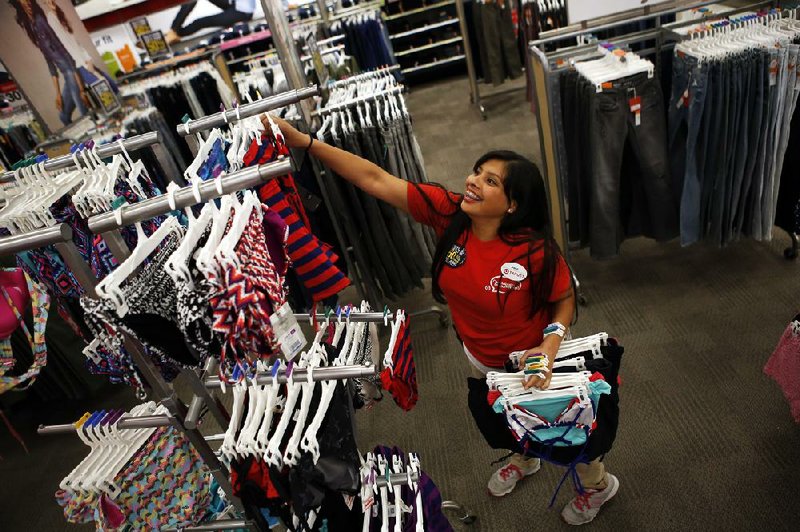U.S. retailers are suffering through the slowest back-to-school shopping season since the recession ended in 2009, raising concern that Christmas shopping will bring more of the same.
Spending in the period, which continues through the end of the month, has risen 3.1 percent, missing a forecast for a 3.2 percent gain, according to research firm Customer Growth Partners LLC. That's the smallest increase in more than five years.
Another ominous sign: Store traffic declined 4.2 percent in July and slipped an additional 4.7 percent in August, according to ShopperTrak, a Chicago-based research firm.
The back-to-school shopping rush is second only to Christmas in its importance to retailers, and some analysts view it as a harbinger for the rest of the year. Chains have cut prices and stepped up sales promotions to entice customers, without much success, and Internet competition is growing.
"It was by no means robust in any way, shape or form," said Ken Perkins, president of industry tracker Retail Metrics LLC. "Competition is going to remain fierce, and there's going to be a significant amount of promotions taking place."
Gap Inc., the biggest clothing-focused retailer in the U.S., and Urban Outfitters Inc., long seen as a teen mecca, both reported sales declines in August from a year ago.
Shoppers are hunting for the best deals online, making it difficult for retail chains to attract consumers without discounts.
"I always try to get a sale," said Meagan Coomber, a 32-year-old mother of three who lives in Montclair, N.J. "I definitely shop for quality because I want to pass it down, but definitely not full price."
Shoppers were expected to spend about $26.5 billion in the back-to-school period, a drop of 0.7 percent from 2013, according to the National Retail Federation, which hasn't updated its figures since giving that forecast in July. The predicted decline stemmed in part from there being fewer school-age children in U.S. households, a trend that could affect Christmas spending as well.
Sluggish wage growth also may be keeping shoppers from spending more, even as the employment picture is starting to brighten, said Jack Kleinhenz, chief economist at the National Retail Federation. The unemployment rate has declined to 6.1 percent after a six-month burst in hiring this year.
"I don't see any surge in spending until we see a pickup in wages," Kleinhenz said.
While customers are opening their wallets for school supplies and electronics, they may be putting off more discretionary purchases such as apparel. Gap's comparable sales, which include stores open at least a year and Internet orders, fell 2 percent in August. Analysts had predicted a 1.7 percent gain.
At Urban Outfitters, sales are declining by low-single digits this quarter, the company said earlier this month. Urban Outfitters' stock fell 2.2 percent over the past 12 months through Monday, trailing the 17 percent increase of the Standard & Poor's 500 Index. Gap climbed 4 percent over that time frame.
Apple Inc.'s iPhone 6, meanwhile, showed that popular devices remain impervious to a sluggish economy. The company sold more than 10 million units of its latest phones over the weekend, setting a record.
The situation is still far better than during 2009, when recession-worn consumers sent back-to-school sales down 3.5 percent, said Craig Johnson, president of Customer Growth Partners. The best season in the past decade occurred in 2005, when sales jumped 7 percent, he said.
"The lower and middle-income shoppers just don't have a lot to spend on excess items for back-to-school," Perkins said. "There's more of a skew toward discount-oriented retailers."
One discounter that may be benefiting is Target Corp., which said it's seeing early signs of an improvement in consumer demand. Kathee Tesija, chief merchandising and supply chain officer, said during a conference call last month that the retailer was "pleased" with the season to date.
The Minneapolis-based company expects to hire 70,000 seasonal workers to handle the year-end rush, in line with last year. Wal-Mart Stores Inc., meanwhile, plans to hire 60,000 seasonal employees, 10 percent more than last year.
Even with all the challenges, there are signs of optimism within the industry. In August, retail purchases increased 0.6 percent, the biggest rise in four months, according to the Commerce Department, with 11 of 13 categories strengthening.
Declining mall traffic could signal that more back-to-school and Christmas spending is shifting online. Customers also are increasingly researching products before they make targeted store visits, Perkins said. Shoppers are making fewer trips to stores, and when they do buy, they aren't going for impulse purchases.
To prepare for the increase in online buying, shipping companies are beefing up their seasonal labor force. United Parcel Service Inc. will increase seasonal hiring by as much as 73 percent from its peak plan in 2013, when a surge in late Internet orders left the company unable to meet Christmas deadlines. The temporary workforce will number as many as 95,000 people to handle the crush of packages from October through January, the Atlanta-based company said last week.
"Last year really was a breakout year -- it was a quantum leap in terms of online selling," Perkins said. "They're hiring in anticipation of that trend likely continuing."
A Section on 09/24/2014

